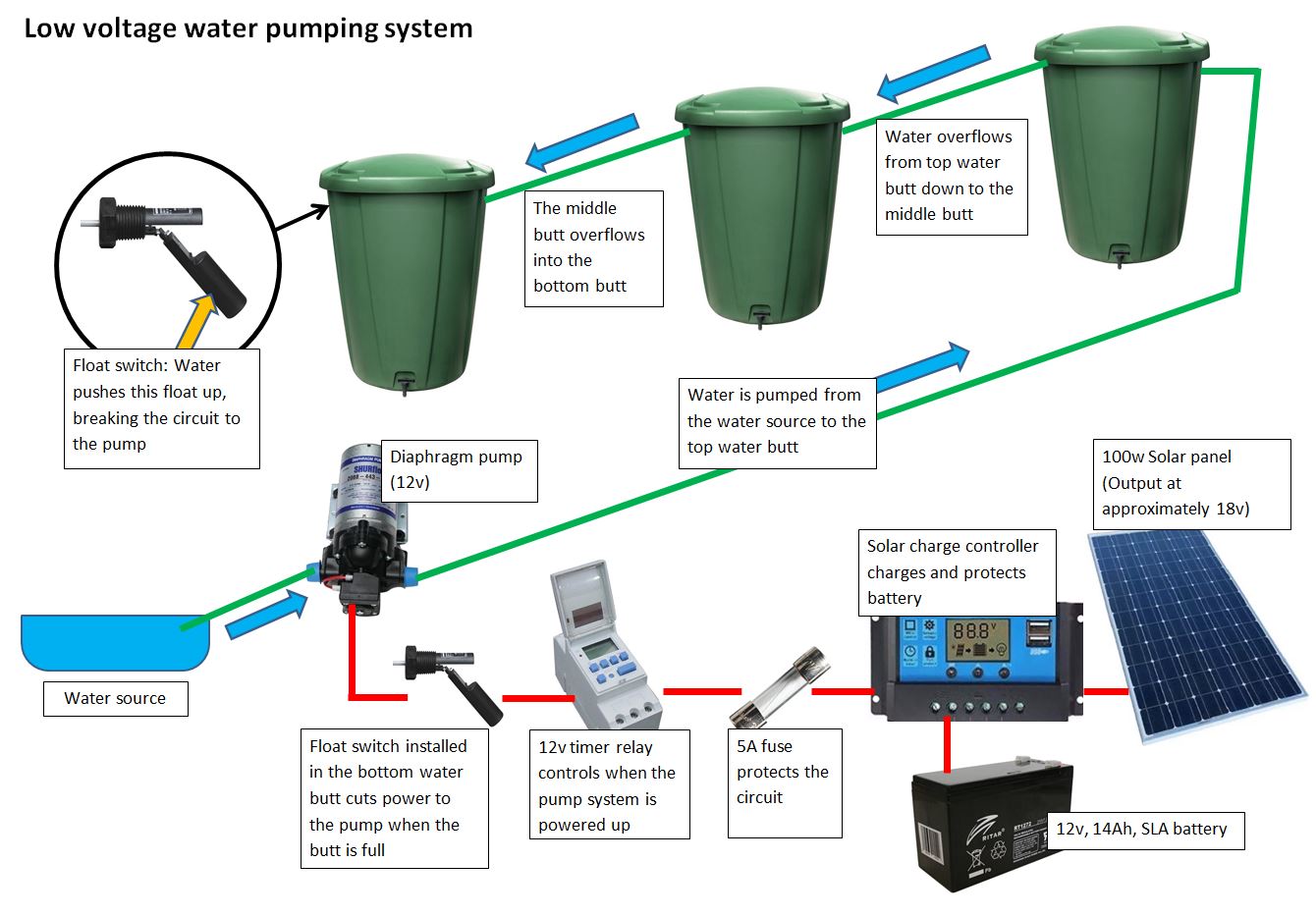Our water system
We are not connected to mains water at the community garden. Fortunately we do have access to a stream, the Afon Cyflymen. In the early days we used to fill buckets from the stream to water the plants. We then moved to a hand pump, before moving to a low voltage solar powered pumping system. Natural Resources Wales allow abstraction up of up to 20’000 litres per day without a license. Our system is set up on a timer so we can only abstract a maximum of 400 litres in a day. Most days we abstract far less, just enough to water the garden.
The current system is described below;

Pump
Our pump is an on demand diaphragm pump. Here is a similar one on Ebay. There are various different pumps of this type. They are rated by power, typically around 50w, and for that power can deliver an amount of water at a pressure. Pumps with higher pressures have lower flow rates – it’s a compromise between the two. Pressure is required to overcome the ‘head’ – the distance vertically you wish to pump.
The pump voltage should match the system/battery voltage. In our case this is 12 volts. It is important the pump is ‘self priming’, this is specified to a vertical distance between the pump and water source.
Battery
Type: We’ve used a sealed lead acid (SLA) battery in this system. They are safe and easy to handle and charge. They can also tolerate high and low temperatures as well as tolerating being deep cycled.
Capacity: Because we pump when the sun shines, we don’t need a large capacity battery. The 12v 14Ah rating of our battery means that at 12 volts it can deliver 14 Amps for one hour. Because this figure is worked out over a 20 hour discharge, it can’t actually deliver 14Amp for an hour, in practise it will probably only be able to deliver about 9 Amps for an hour. However if you did discharge the battery in that way on a regular basis, then it’s service life would be decreased. Capacity is somewhat irrelevant in this system as the pump generally only runs on the sun! It is more relevant for us because we use the battery to run lights in our straw bale building. Our lights draw 2 Amps, and will run for about 4-5 hours on the battery.
Solar charge controller
If you only want to run on sun (no battery), then you can make do without a controller. However this is NOT advisable. For a safe and easy to use system a controller is essential. The controller will ensure that the correct voltage reaches the battery and pump. It will protect the battery from over charging, and over discharge. When you buy a charge controller it should come with full instructions on how to wire it. Make sure the controller can handle your maximum current. Although our maximum load is 8 Amps (pump running and lights on in straw bale building) We have a 20A controller to give us headroom. Here is a controller that is similar to ours on Ebay.
Fuse
It is important to include a fuse in the system to protect from short circuits. The fuse rating should be slightly higher than the maximum pump current. In our case we use a 5 Amp fuse as our pump draws a maximum of 4 Amps.
Enclosure
For safety it is important that all live components are contained in a locked or secured enclosure. While 12v is generally safer than mains voltage, you still don’t want to allow prying fingers anywhere near the circuitry. We enclose all of the circuitry in a wooden box underneath our solar panel. The box has a lid which is screwed shut. Cables run to the pump from the box, and these are buried under the ground in protective conduit.
More to follow
If you have any questions in the mean time, please feel free to get in touch.
